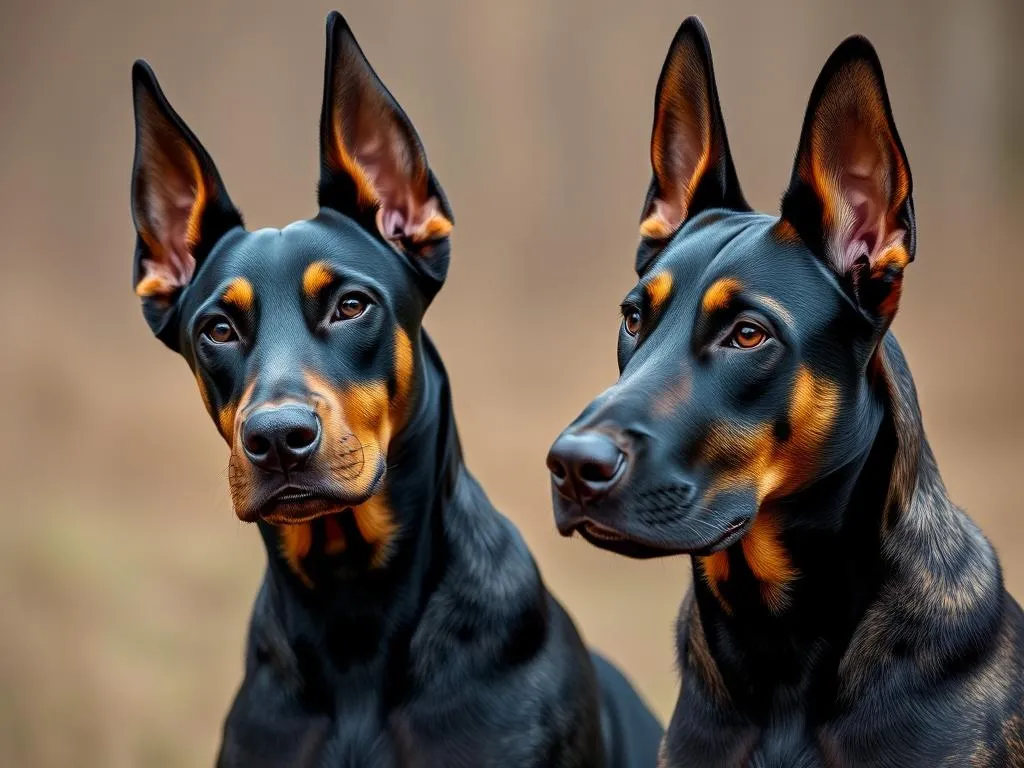
Choosing the right dog breed is a significant decision, influenced by factors like lifestyle, preferences, and the specific roles these dogs will play in your life. Among the most popular breeds in various roles, Dobermans and Belgian Malinois stand out for their intelligence, loyalty, and versatility. These breeds are beloved as family pets and recognized for their skills in working environments, including police and military roles.
Understanding the characteristics of each breed can help potential owners make informed decisions, especially when considering training, temperament, and lifestyle compatibility. In this article, we will delve into a comprehensive comparison of Doberman and Belgian Malinois to aid in your choice.
Breed Origins and History
Doberman
The Doberman breed originated in Germany in the late 19th century, primarily developed by a tax collector named Karl Friedrich Louis Dobermann. He sought a loyal and protective companion to accompany him on his rounds, leading to the creation of this breed.
Initially bred as a guard dog, the Doberman quickly gained a reputation for its intelligence and protective instincts. Over the years, they were utilized in various roles, including police dogs and military dogs, thanks to their keen senses and ability to be trained for specific tasks.
Belgian Malinois
The Belgian Malinois is one of four types of Belgian Shepherd dogs, originating from Belgium in the late 1800s. The breed was developed primarily for herding sheep and was named after the city of Malines.
Like the Doberman, the Belgian Malinois has also served in various working roles, especially in police work and search and rescue operations. Their agility, intelligence, and strong work ethic make them ideal candidates for these demanding tasks, earning them a respected place among working dog breeds.
Physical Characteristics
Doberman
Size and Weight
Dobermans are medium to large-sized dogs, typically standing between 24 to 28 inches tall and weighing between 60 to 100 pounds. Their athletic build and sleek appearance contribute to their powerful presence.
Coat and Color
Dobermans have a short, smooth coat that is easy to maintain. Common colors include black, blue, red, and fawn, often with rust-colored markings on the face, chest, and legs.
Belgian Malinois
Size and Weight
The Belgian Malinois is slightly smaller than the Doberman, standing around 22 to 26 inches tall and weighing between 40 to 80 pounds. They possess a well-proportioned, agile body that enhances their speed and performance.
Coat and Color
Malinois have a short, dense coat that is typically fawn or mahogany with a black mask. Their coat is slightly longer around the neck and chest, giving them a distinguished appearance.
Temperament and Behavior
Doberman
General Temperament
The Doberman is known for its loyalty and protective nature. They are intelligent dogs that are eager to please, making them highly trainable. However, they can be wary of strangers, which can manifest as protective behavior.
Behavioral Traits
Dobermans are generally not aggressive but can show aggression if not properly socialized. They are highly sociable with their families and require consistent training and socialization to thrive in various environments.
Belgian Malinois
General Temperament
The Belgian Malinois is an intelligent and energetic breed, often described as alert and confident. They thrive on mental and physical stimulation, which makes them excellent working dogs.
Behavioral Traits
Similar to Dobermans, Malinois require proper training and socialization. They are known for their high energy levels and can become destructive if not given enough exercise or mental challenges. Their loyalty to their families is strong, but they may be reserved around strangers.
Training and Exercise Requirements
Doberman
Training Needs
Dobermans respond well to positive reinforcement training methods. Early socialization is crucial to prevent any overly protective tendencies. Consistent training sessions help them become well-adjusted companions.
Exercise Requirements
Dobermans require substantial daily exercise—at least 60 to 90 minutes. Activities like brisk walks, running, and playtime in a secure area are essential to keep them physically and mentally stimulated.
Belgian Malinois
Training Needs
Training a Belgian Malinois can be a rewarding experience due to their eagerness to learn. Positive reinforcement techniques work best, and early socialization is vital. Given their intelligence, they excel in obedience training and can master advanced commands quickly.
Exercise Requirements
Malinois are highly energetic and require even more exercise than Dobermans. They need at least 90 minutes of vigorous physical activity each day. Activities such as agility training, obedience classes, and interactive play can help channel their energy productively.
Health and Lifespan
Doberman
Common Health Issues
Dobermans are prone to specific health issues, including dilated cardiomyopathy (a heart condition), hip dysplasia, and von Willebrand’s disease (a bleeding disorder). Regular vet check-ups can help identify and manage these risks.
Lifespan
The average lifespan of a Doberman is around 10 to 13 years. Factors such as genetics, diet, and overall care significantly impact their longevity.
Belgian Malinois
Common Health Issues
Belgian Malinois are generally healthy but can be susceptible to hip and elbow dysplasia, progressive retinal atrophy, and certain skin conditions. Regular veterinary care and a healthy lifestyle can mitigate these issues.
Lifespan
The average lifespan for a Belgian Malinois ranges from 12 to 14 years, and like Dobermans, their health is influenced by diet, exercise, and genetics.
Ideal Living Conditions
Doberman
Best Environment
Dobermans thrive in environments where they have ample space to move and play. They adapt well to various living conditions, including apartments, provided they receive enough exercise.
Family Compatibility
Dobermans can be excellent family pets, especially in households with older children. They bond closely with their families and can be friendly with other pets if socialized early.
Belgian Malinois
Best Environment
The Belgian Malinois requires a more active environment due to their high energy levels. A home with a large yard or access to open spaces is ideal, as they thrive on physical activities.
Family Compatibility
Malinois can adapt well to families, especially those that are active and engaged. They do best in homes with older children who can play and interact with them, but they may be reserved around unfamiliar pets without proper introductions.
Cost and Adoption Considerations
Doberman
Purchase vs. Adoption
The cost of acquiring a Doberman from a reputable breeder can range from $1,500 to $3,000, depending on lineage and location. Adoption is also an option, often at a much lower cost, typically around $100 to $300.
Ongoing Costs
Monthly expenses for a Doberman can include food, grooming, healthcare, and training, which may total around $150 to $300. It’s essential to budget for regular veterinary visits and potential health issues.
Belgian Malinois
Purchase vs. Adoption
The price of a Belgian Malinois from a breeder can range from $1,000 to $2,500, depending on the dog’s lineage and training. Adoption fees usually range from $100 to $400.
Ongoing Costs
Monthly costs for a Malinois, including food, healthcare, and training, can also range from $150 to $300. Like Dobermans, they may require additional funds for training and health care.
Conclusion
In summary, both Dobermans and Belgian Malinois are exceptional breeds with distinct characteristics that suit different lifestyles. Dobermans offer a loyal, protective nature while being highly trainable and adaptable. On the other hand, Belgian Malinois are energetic and intelligent, excelling in active environments where they can channel their energy productively.
When considering which breed might be the best fit for you, think about your lifestyle, activity level, and the time you can dedicate to training and socialization. Each breed has unique traits and requirements that can significantly influence their compatibility with your household.
FAQs
1. Are Dobermans good with children?
Yes, Dobermans can be excellent family pets, particularly with older children. Early socialization is key.
2. How much exercise does a Belgian Malinois need?
Belgian Malinois require at least 90 minutes of vigorous exercise daily to stay healthy and prevent behavioral issues.
3. Do Dobermans shed a lot?
Dobermans have a short coat that sheds moderately throughout the year, requiring regular grooming to manage loose hair.
4. Can a Belgian Malinois live in an apartment?
While they can adapt to apartment living, a Belgian Malinois needs ample exercise and mental stimulation to thrive.
5. What is the average lifespan of a Doberman?
The average lifespan of a Doberman is between 10 to 13 years, influenced by genetics and overall care.









